by Mike Rogers
illustrations by Dave Goodsell
This article is an annotation of an item I published in the June 1986 issue of MUM. There are several adjustments adding more historical information. The excellent illustrations were drawn by MUM editor Dave Goodsell, he of West Coast Wizards Magic Camp fame. Incidentally, the cover subject of that particular issue of MUM is a popular beloved American magician who, quite frankly, lacks common sense. For instance, he thinks the Classic Pass is a method for picking up girls in the classical manner, the Paddle Move is a form of child discipline, and the Double Lift is an under garment for the lusty and busty gender. How foolish. Everyone knows the Double Lift is a fan of two cards.
Dig deep into that old shoe box of unused items, pull out your WILD CARD set and follow along. The WILD CARD effect has been around for more than 35 years. During that time it has been kicked, hashed, rehashed, embellished, shortened, lengthened, discarded, reinvented, improved, and screwed up every way possible. Through it all, it has sold by the thousands as a standard dealer item. It started the packet craze and might be the best known packet trick in existence. However, it is seldom seen in its original form, whatever that might be … I’ll even go so far as to say that it is seldom seen in any form, as it seems to have fallen out of popularity. To add to all this, the creation of the effect has caused considerable controversy as to who actually conceived the notion. For years Frank Garcia was considered the father of the WILD CARD, and the original Tannen release carried Frank’s name. Pictured here is one of the original vinyl card cases used for the trick by Lou Tannen. Somehow Lou successfully pulled one of the most astute marketing moves in the sale of magic. Lou was able to sell them by the thousands before other vendors were able to obtain the needed cards and package it themselves. Garcia used to say Lou Tannen enjoyed retirement because of WILD CARD. (I question that.) Ethics among magic dealers has not always been of the highest standard, and dealers around the world jumped on the band wagon and started putting together their own sets. By then Tannen had already flooded the market. Later it was learned that the original concept came from the creative mind of Peter Kane; hence, a flap in the making that has never died.
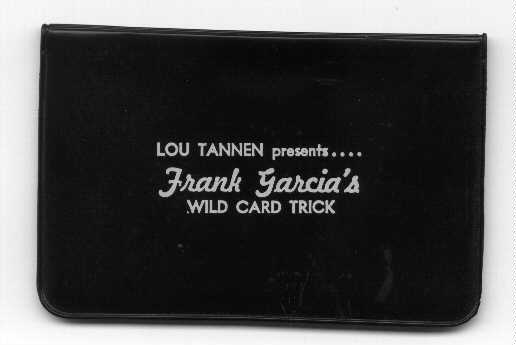
My point is not to establish who did or who didn’t, but any discussion of the WILD CARD would be incomplete without some mention of various names and places. Garcia has taken heat; Peter Kane currently receives credit; while others have contributed significantly to the winding path of the effect. Incidentally, Frank Garcia did the effect flawlessly. A name seldom mentioned is TV star Bob McAllister. Bob was one of the first to realize the commercial appeal of the effect; and he was one of the first to start playing with the glide as different handling. Derek Dingle and Larry West each took the effect and shook it like a dog with an old shoe. Hence, Derek’s “Wild Fire” and Larry’s “Wild Wild West.”
Gimmicked and ungimmicked versions have been appearing in magic publications for years. It has been done with cards having pictures, symbols, signatures, blank, and even cut in half. The late Bob Snodell used to print the special cards having company logos for Eddie Tullock and me to use in trade shows. (Neither Eddie nor I ever cared much for that idea.) Frank Garcia wrote a complete book about it as did Jon Racherbaumer. Jon’s book, published in 1992, is called THE WILD CARD KIT. Along with the book you received the necessary cards in poker size. Jon’s bibliography lists over 40 references regarding the effect. Brother John Hamman had a published version gaffed to the extreme called WILD ALL THE WAY. Derek Dingle had a published version in the New Stars of Magic called WILD FIRE. It is good, but a better version from Derek appears in his Complete Works book, and is called WILD MOVE. The late Jack Gwynn told me that WILD CARD was the only close up effect he ever learned, and until he saw WILD CARD he had never considered doing a close up trick. One of the finest presentations I’ve seen was performed by Mark Wilson on network TV. If you want to really have fun, without working hard, check out TAMING THE WILD CARD by Racherbaumer in the September 1991 issue of The New Tops. In essence it is the same as Mark Wilson used for the TV performance. For many years Dick Ryan used the trick as his tip builder on the aisle of trade shows. Even the purists do it in some form, their idea normally being to eliminate the use of the gaffed cards.
I’ve only scratched the surface, as attested by the 40 reference entries in WILD CARD KIT.
So the beat goes on.
Before getting into my handling of the trick I’ll relate an amusing anecdote concerning Al Cohen. It’s just one of the reasons he has so many friends in magic. I walked into Al’s shop and saw Al performing WILD CARD on the display counter while talking on the phone. It seems a layman customer had purchased WILD CARD while on a business trip to Washington, D. C. The guy was staying in a Washington hotel, and while there he was attracted to Al’s shop. The idea of having a magic trick appealed to him. When he returned to his hotel and read the instructions he simply couldn’t comprehend the action. This is not uncommon with laymen, for magicians do seem to have their own jargon. Anyway, the guy tried and tried, finally phoning Al for some guidance. While holding the phone to his ear using his shoulder, Al took a WILD CARD set and went through the entire routine on the counter explaining what he was doing at the time. On the other end the guy had his WILD CARD set laid out on his hotel bed following along. Al Cohen is a great guy!
What have I got to add? Still another version. First, let’s discuss the basic effect as sold by Tannen 35 years ago. The effect is short and simple. Eight identical cards are shown, plus a ninth indifferent card, which is said to be “wild.” The identical cards are placed on the table, four face up and four face down. These cards are then “influenced” by the “wild” card, at which time every card changes value to match the value of the wild card. That’s it, but what an understatement!
For the most part I have retained the original approach, but have adjusted the handling a bit. In the original handling as sold by Tannen, the identical cards are shown by first showing four of them, then the “wild” card, then the remaining four. At least that’s what it is to seem. I have always felt that showing the wild card in the middle was illogical. I feel that you should first show the eight identical cards and then the wild card. I have never liked showing the wild card in the middle of the count. Others have felt the same and, as a result, have solved the problem by repeated use of the glide. That method does the job beautifully except for one thing. Very few can do repeated glides without having an extra card drag out at the wrong time. When that happens, the trick goes down the drain before ever getting off the ground. Moreover, I personally do not like the glide. In the routine that follows I’ve handled the problem by adding one additional card to the standard marketed set. The handling allows for the identical cards to be shown one at a time all together.
Before getting into it, let’s expose the gaffus up front getting that out of the way. Double-faced cards are used. This thing has been fair game for so long that no one should be upset at this point when a version appears in print. Besides, the double-faced cards have to be purchased, and the best way to get them is simply to buy the original WILD CARD set from your local dealer.
Credit for the one sleight needed goes to Brother John Hamman. Inspirational credit for the method of showing the like cards all together goes to Derek Dingle. Francis Carlyle deserves mention, too, as I’m told that my ending duplicates his ending, though I never saw Carlyle do the trick.
Now on to what I have to offer. This handling duplicates the original effect. Eight identical cards change to the value of one single wild card. My set uses a total of ten cards; and by adding just one normal card to your WILD CARD set you are in business. Let’s assume you are going to change a group of 9’s to a group of 2’s. That’s one of the sets as sold by dealers because the Nine of Clubs/Two of Diamonds is a standard double-faced card.
The setup is this. Place on the table, face up, five normal 2D’s in a stack. Place on this stack a normal 9C, also face up. This is the one card you have added to the WILD CARD set. Now on the face of the tabled stack place four gaffed cards: 9C/2D, nine side showing, You are now ready.
Incidentally, it’s not logical that anyone in the real world would ever have such a collection of cards for any reason. This can be overcome by using jokers, the idea being you collect jokers from new decks as you open them. Anyway, I’ll continue to describe it with nines as that’s one of the standard WILD CARD sets. Introduce the packet of cards and hold face up in the left hand in dealer’s position. Comment that you collect 9’s. With that patter line, fan the 9’s one at a time into the right hand until all five of them show, and on the fifth nine do a block push off of all remaining cards except the bottom card. A 2D will show on the bottom. Don’t comment about the number of cards or the number of 9’s. Simply show a bunch of 9’s and a single 2D (see sketch #1).
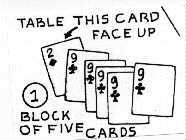
Comment that deuces are “wild,” so this card will be used later. Place the deuce face up to one side. You now comment that you have a total of nine 9’s; and, as you patter, you show just that by doing the Hamman Count in the following manner. Holding the face-up packet in the right hand, in the Biddle Grip, you peel the first four cards into the left hand fairly. On the count of five, you exchange the two blocks and continue counting, showing nine cards all having the value of 9C. Now turn the cards face down and repeat the count; that is, exchanging blocks on the count of five. You have shown nine cards face up and face down. All appears to be fair. Turn the block face up again. Incidentally, the block exchange on the Hamman Count gives many magicians problems. All I can say is work on it and it will come naturally after a bit.
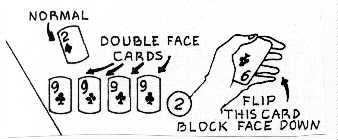
With the block of cards face up, deal the first four cards to the table as shown in sketch #2. Now turn the remaining cards face down and deal the next four cards to the table face down. These are the normal 2D’s. Turn the one remaining card face up, and all will appear as in sketch #3.
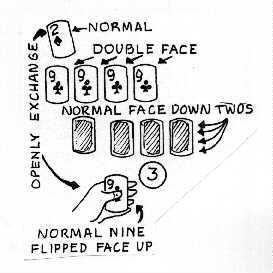
Comment that you will exchange a 9C for the “wild” card; and you do just that, swapping the 9C you hold for the tabled deuce (see sketch #3 again). Comment that you will now influence each card with the “wild card.” What you are going to do is the same move as used by Allerton in his TWO CARD TRICK, page 22, Allerton’s THE CLOSE UP MAGICIAN. Place the card you hold under a tabled card and picking up both, turning them both over as you do. Sketches #4 and #5 show the result. The normal 2D is placed under one of the double-faced cards, and both cards are turned over in a continuous movement. Place the 2D that is showing on the table and take the face-down card (a 2D) and snap it turning it face up, showing it now to be a deuce.
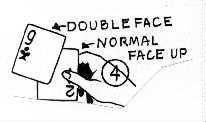 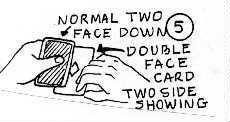
With this normal deuce do the same move, only this time do it with one of the face-down cards. Again, the 9C seems to have changed to a 2D. Before going on, let’s admit there’s a discrepancy here. The turnover move makes no sense, but oddly enough it looks normal and will be accepted. Even more strange, it takes on the same appearance when done with a face down normal card as it does with a face up double-faced card. Continue with this turning and changing business until all the cards have changed to show a value of 2D. Scoop up the row of normal 2D’s (sketch #6), flash their backs, then use them to scoop up the row of fakes . It’s not necessary, but you can again do the Hamman Count to show all backs. The faces will all show as 2D’s without any monkey business. Stop here. Don’t add to it by changing things back to 9C’s. You want only one climax.
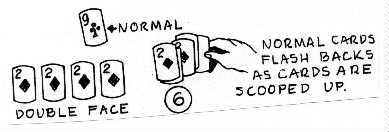
|
